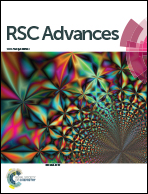Monodomain hydrogels prepared by shear-induced orientation and subsequent gelation
Abstract
Biomimetic soft materials with well-ordered structures have received increasing attention due to their potential applications in artificial tissues, soft actuators, and optical devices. We demonstrate here the synthesis of anisotropic hydrogels from concentrated liquid crystalline solution of hydroxypropylcellulose (HPC; content ≥ 45 wt%) with high viscosity. Monodomain precursor solution of HPC, in the presence of reactants, is obtained by mechanical shearing, which is immediately subjected to UV light irradiation to trigger the polymerization and thus to freeze the ordered structure of HPC before severe structural relaxation. The as-prepared HPC-containing poly(2-acrylamido-2-methylpropanesulfonic acid) gels are transparent and show uniform birefringence, Δn of 1.7 × 10−3, and pronounced anisotropic mechanical properties, with larger tensile modulus and breaking stress, yet smaller breaking strain when stretched parallel to the shear direction than those perpendicular to the shear direction. The gels also show anisotropic swelling ratio, with larger value in the direction perpendicular to the shear direction. The swelling anisotropy decreases from 1.22 in water to 1.09 in 1.5 M saline solution, which is related to the weakening of optical and mechanical anisotropy of swollen gels. This approach to prepare anisotropic gels should be suitable to other LC natural and synthetic macromolecules with high viscosity.


 Please wait while we load your content...
Please wait while we load your content...